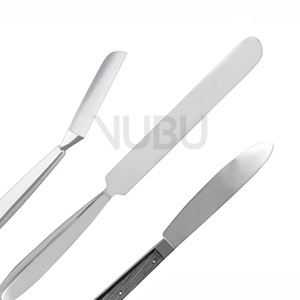The Walb autopsy knife is an essential tool in pathological diagnostics and is particularly used during autopsies. It is characterized by its rounded, curved tip, which enables precise and gentle cutting through various types of tissue. This unique design minimizes the risk of unintended tissue damage and facilitates work with delicate structures. The ergonomic handle is made of a sterilizable, wood-like material, ensuring not only comfortable handling but also meeting high hygiene standards. This is especially important in forensic pathology, where cleanliness and precision are top priorities.
Our Virchow brain knives are specifically designed for the demands of neuropathology and are available in sizes of 16 cm, 20 cm, and 24 cm. These instruments feature a double-edged blade, which allows for clean and precise cutting of brain tissue. The rounded tip prevents accidental damage to the delicate tissue and facilitates the preparation of brain samples. Virchow brain knives are indispensable for the histological examination of neurological diseases and contribute to accurate diagnostics.
The Rehn and Thiersch transplantation knives are highly specialized instruments primarily used in dermatology and plastic surgery. They are designed for harvesting skin grafts and are characterized by their rounded tip and an extremely sharp blade. While the Rehn knife has a straight blade, the Thiersch knife features an angled blade, which is particularly suitable for harvesting thin skin layers. This design allows for precise and gentle harvesting of skin grafts without unnecessarily damaging the surrounding tissue. Both models are essential for reconstructive surgery and the treatment of burns or skin defects.
The use of highly specialized instruments such as the Walb autopsy knife, Virchow brain knives, and Rehn and Thiersch transplantation knives is crucial for the quality of diagnostics and treatment. Precision, ergonomics, and sterilizability are key factors that not only make the work of professionals easier but also enhance patient safety and diagnostic accuracy. Each of these instruments is tailored to the specific requirements of its field of application, contributing to more efficient workflows and better outcomes.
